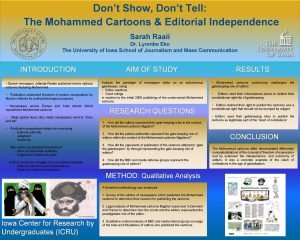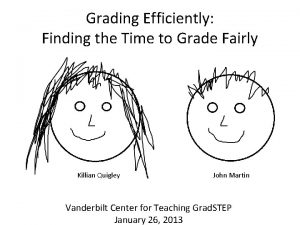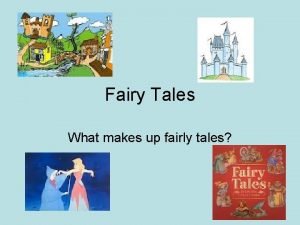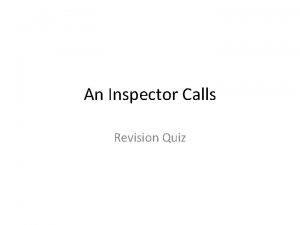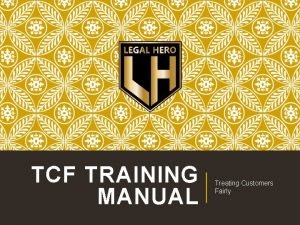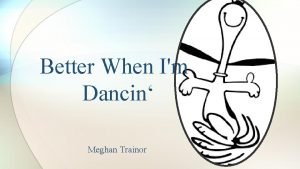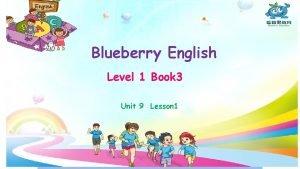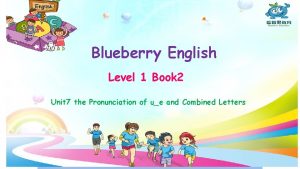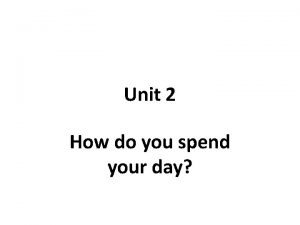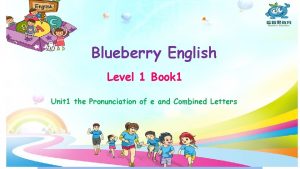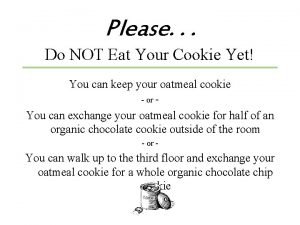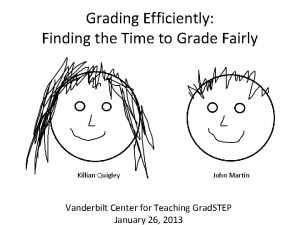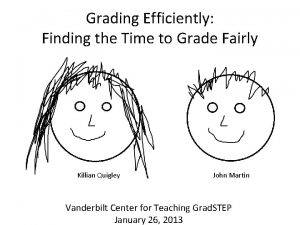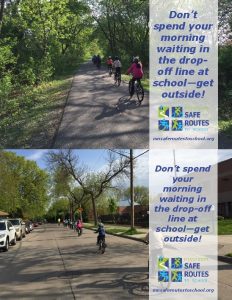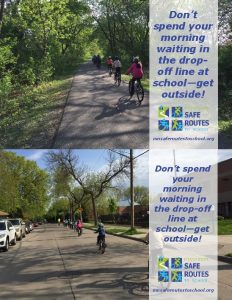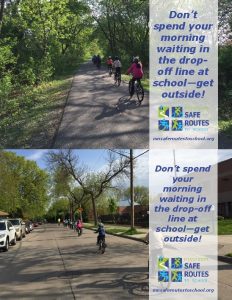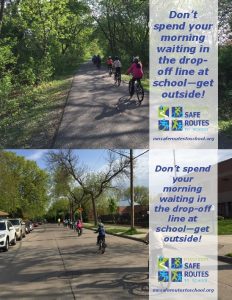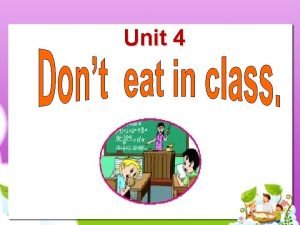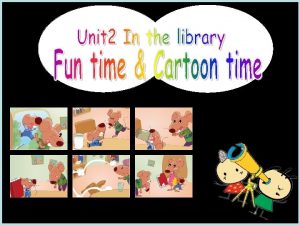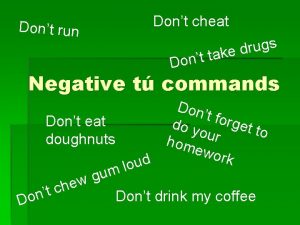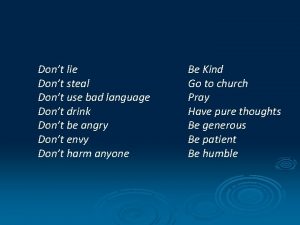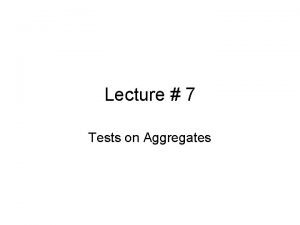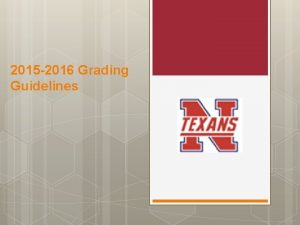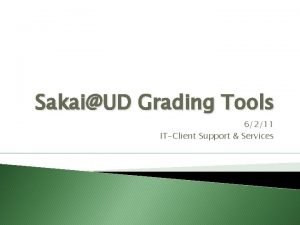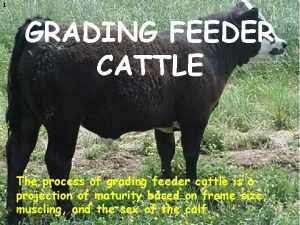Dont Spend Your Life Grading How to fairly
























- Slides: 24

Don't Spend Your Life Grading! How to fairly and accurately assess your students using Formative and Summative strategies

Problems with Grading everything we assign is a TIME SUCKER!!! We grade it, they toss it! Cheating….

Formative vs. Summative Assessment WE DON’T NEED TO GRADE EVERYTHING! Much of the work that we typically assign to students is designed to help them learn the new content…. they are working toward meeting a standard These daily assignments should contribute less toward a student’s overall grade Are you getting it vs. what have you learned Most of the time, we need to provide quick feedback on these daily assignments so student’s can evaluate their progress – hard to do if we collect and “grade” it all!

Formative Assessment can be…. Quick Informal – NOT graded Frequent Fun (sometimes) Informative to: Student Teacher Peers

Formative Assessment Ideas Thumbs up / Thumbs down Traffic light – use stickers or colors (red/yellow/green); when students are working in groups, use colored SOLO cups Finish the face – blank face with bubble cloud; students draw an expression showing how they feel about the topic and write something they shouldn’t forget in the bubble Q & A – have students write a question about a topic on a slip of paper / redistribute and have another student answer the question A picture tells a thousand words – take a picture of students working (on a lab, etc) and ask them to describe what they were doing

More…. Formative Assessment Ideas Acrostic poems – use the first letter in the word of a concept to describe that concept Table graffiti – students write or draw info about a topic on butcher paper (assign different colors to students so you can quickly assess who wrote what) Synetics – relate a topic to random words (create analogies)

Technology based…. Formative Assessment Ideas Google Forms Kahoot! https: //getkahoot. com/ Go. Soap. Box http: //www. gosoapbox. com/ Socrative - https: //www. socrative. com/ Quiz. Up - https: //www. quizup. com/en

ONGOING…. . Formative Assessment Ideas Exit Ticket open can ended be more or less structured Formative Assessment probes incorporates good writing (argumentation) for pre-assessment

Case Studies Very “Common Core”! Real-world application Interactive (group or whole class) Often require writing May use embedded questions to allow for immediate feedback (use technology based student feedback tool such as Socrative) Website: National Center for Case Study Teaching in Science

Holding Students Accountable SOME daily assignments do need to be evaluated However, we need to minimize the impact of cheating – did the student really do this work? In many cases, we don’t need to grade the ENTIRE assignment…. we just need to know if they are “getting it” WHAT’S THE SOLUTION? ? ? ?

The Daily Progress Check Hold students accountable for assignments Allows credit for accuracy AND completion Allows for immediate feedback You (the teacher) grade ONE sheet of paper for each unit/module and record ONE grade Progress Check Explanation and Resources

The Interactive Science Notebook A great organizational tool Everything is in one place: warm-ups, notes, daily assignments, lab reports, writing samples Can be used in many different ways : all CW/HW or just a daily “journal” How to set up and evaluate the science notebook or journal (Stolen from Cindy Rudolph ) Use a stamp for quick assessment / accountability Collect periodically and grade with a rubric

Student Portfolio Holds students accountable Allows students to correct work based on deepened understanding You grade ONE “portfolio test” that can check as many assignments as you wish Portfolio Explanation Drawback: Students do not keep assignment for further review

The Lab / HW Quiz For labs and activities done as a group, individual accountability can be tricky – how do we know that EVERY student understands? Unfortunately, when work is done at home, cheating often occurs with students copying each others’ papers Grading multiple lab reports can be VERY time consuming WHAT’S THE SOLUTION? ?

The Lab / HW Quiz Multiple Choice or Short Answer quizzes to check for accuracy and understanding (can provide a set of common data for labs if needed) Allows for individual accountability You may allow students to use their own work on the quiz – rewards students who answer thoroughly Allows for the possibility of group lab reports

Speaking of Group Work…. Other ideas for ensuring individual accountability (so YOU don’t have to grade EVERY paper!) Monitor for participation The “Selector” app (can be downloaded to teacher device) – chosen individual has to answer a question or turn in his/her paper Low-tech solution – The Randomizer (Place marbles in a small opaque plastic container… one a different color than the rest. Cut a small hole in the top of the container. Each student inverts the container and allows one marble to fall into his/her hand. When all students have a marble, reveal colors. The student with the different color turns in his/her paper for the group) Video lab reports – require each person to participate

Summative Assessment What have students LEARNED Should count more toward a student’s overall average! (Current CMS split 70% summative / 30% formative) MAY be a “test”…. . but not necessarily Other possible work products? Important to fairly and accurately assess these tasks because they reflect what students have actually learned – can be VERY time consuming! WHAT’S THE SOLUTION?

Using Rubrics are a teacher’s best friend! Sets a standard Empowers students to earn a desired grade when rubric is given along with assignment May take MANY different forms…. Acid Deposition Lab Endangered Species Project Karyotype Lab Ecology Story Notebook / Journal

Self or Peer Evaluation Rubrics can be used to allow students to evaluate their own work, or that of an anonymous peer. To ensure accuracy: YOU review the rubric with the students! Have multiple students evaluate the same work using the same rubric. Have students evaluate their own work as you go over the rubric, then you come behind to confirm their assessment (less time consuming). This is particularly useful when grading AP work (ie. FRQ’s)!

Concerns about "weight" of summative assessments What about students who don’t test well? Remember – summative assessments don’t HAVE to be a traditional test However, students DO need to be able to do well on traditional tests due to EOC test / Common exam format WHAT’S THE SOLUTION? ? ?

Improving Test Performance Teach test-taking skills!!! Offer options to improve test scores. Some ideas: Re-take entire test and replace grade Test corrections – only change incorrect answers / student gets partial credit Write out question and answer of missed questions; find supporting info in course materials (see test corrections form) Identify important vocabulary or concept in missed questions and define / explain Give student correct answers for missed questions and they explain why other answer choices are incorrect Why did I miss this? (didn’t know content, wording was confusing, didn’t read carefully, etc)

Mastery instruction We are moving toward a mastery model – ideally teachers work with students until they meet a standard. How do we make time for this? What do we do with students who HAVE met a standard?

Differentiation Building in class time to re-teach / re-test allows opportunities for differentiated instruction Students who have NOT met a standard get reinforcement, while those that HAVE met the standard get enrichment Examples: Cell division DNA and Protein Synthesis

Contact Information Shari Mudd Butler High School 980. 343. 6300 Shari. mudd@cms. k 12. nc. us http: //muddscience. weebly. com/ Thanks for coming!!!
 Past simple i past continuous i past perfect
Past simple i past continuous i past perfect Dont ask dont tell political cartoon
Dont ask dont tell political cartoon Don't laugh at me allen shamblin
Don't laugh at me allen shamblin Fairly satisfactory grade
Fairly satisfactory grade How can governments ensure citizens are treated fairly
How can governments ensure citizens are treated fairly Fairly tales
Fairly tales The fairly intelligent fly
The fairly intelligent fly Inspector calls quotes
Inspector calls quotes Treating customers fairly training
Treating customers fairly training Ptc taster definition
Ptc taster definition Actg 2p12
Actg 2p12 I bet you
I bet you Dont sacrifice pervades your mahal india
Dont sacrifice pervades your mahal india How you spend your leisure time
How you spend your leisure time Where did you spend your last summer holidays
Where did you spend your last summer holidays Where you (spend) your holidays last year
Where you (spend) your holidays last year She……… ill last sunday *
She……… ill last sunday * My summer holidays listening
My summer holidays listening How did you spend your day
How did you spend your day Last summer holiday
Last summer holiday Enagic compensation plan
Enagic compensation plan Give us your hungry your tired your poor
Give us your hungry your tired your poor What they don't know can't hurt them
What they don't know can't hurt them Dont remplace
Dont remplace Please dont eat my cookies
Please dont eat my cookies

